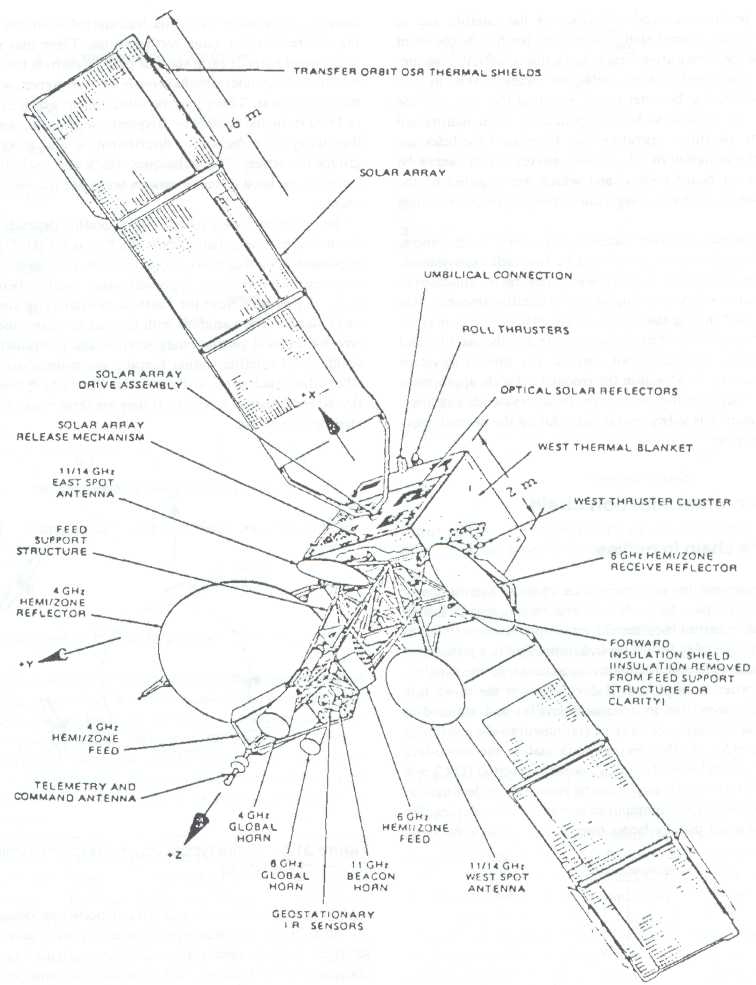
- •51Communication satellites and systems Part I 51.1-51.3.2 (Background)
- •51.1 Background
- •51.2 International regulations 51.2.1 Frequency bands
- •51.2.2 Constraints on frequency assignments
- •51.3 Spacecraft technology
- •51.3.1 Orbits
- •51.3.2 Launchers and launching
- •Part II 51.3.3-51.3.6 (Orbital perturbations and their correction)
- •51.3.3 Orbital perturbations and their correction
- •51.3.4 Attitude stabilisation
- •51.3.5 Electrical power supply in space
- •51.3.6 Telemetry, tracking and command
- •Part III 51.4.1-51.4.3(The communication chain)
- •51.4 The communication chain
- •51.4.1 The chain in outline
- •51.4.2 Space-earth Propagation
- •51.4.3 The transponders
- •Part IV 51.4.4-51.5( Satellite antennas and footprints)
- •51.4.4 Satellite antennas and footprints
- •51.4.5 Modulation techniques
- •51.4.6 Multiple access methods
- •51.5 Applications
- •Part V 51.6.1-51.7(Satellite systems)
- •51.6 Satellite systems
- •51.6.1 Trunk telecommunications
- •51.6.2 Thin route telecommunications
- •51.6.3 Satellite communication for mobile stations
- •51.7 Future developments
- •51.8 Acknowledgements
51.3.4 Attitude stabilisation
Stabilisation of a communication satellite's attitude relative to the Earth is necessary, in order that the gain of directive satellite antennas may be used to use satellite power efficiently and to permit geographical re-use of spectrum. Spinning body stabilisation has been widely used in the past but three axis body stabilisation is in general use now.
In a spinning body satellite the satellite body rotates at 30rpm to l00rpm about the axis which is perpendicular to the plane of the orbit. Antennas are usually mounted on a rotatable platform which is 'de-spun' relative to the Earth and is, accordingly, stabilised in all three axes. A reference to enable the on board control system to keep the antenna platform continually pointing towards the Earth is usually obtained from infra red Earth sensors, supplemented by Sun sensors. Antenna pointing accuracy of +_0.2° or better is obtained with such systems. The thrusters which are used for east-west orbit adjustment are usually mounted on the rotating body of the satellite, and these thrusters accordingly must be operated in a pulsed mode, synchronised with the rotation of the body.
Body stabilised designs generally employ an internal momentum wheel with its axis perpendicular to the plane of the orbit. Control of attitude about the pitch axis is obtained by varying the speed of rotation of the wheel. Hydrazine thrusters are used occasionally to dump momentum from the wheel, so avoiding an unacceptable build up of rate of rotation. Control about the yaw and roll axes may be obtained by gimbaling the wheel or by the use of hydrazine thrusters. Figure 51.4 shows INTELSAT V, a typical large body stabilised satellite (Fuenzalida et al., 1977).
The ITU Radio Regulations require geostationary satellites in general to be capable of maintaining their antenna beams within 10% of the half power beamwidth, or ±0.3°, of the nominal direction, whichever requirement is less stringent (ITU, 1990p). The frequency assignment plans for satellite broadcasting at 12GHz require beam pointing within ±0.1° (ITU, 1990g).
51.3.5 Electrical power supply in space
Silicon solar cells are used as the primary satellite power source in normal operation. When the Sun, for the satellite, is eclipsed by the Earth, power is maintained by nickel cadmium or nickel hydrogen secondary batteries. Full shadow eclipse for geostationary satellites occurs on 44 nights in spring and 44 nights in the autumn, the longest eclipses occurring at the equinoxes and giving 65 minutes of full shadow. Research on new types of storage cell, such as the silver hydrogen cell, seeking longer life, lower mass and higher efficiency, is in progress.
Spinning body satellites have body mounted arrays of solar cells, typically producing about 10 watts per kilogram of solar array mass. Body stabilised satellites using extendable arrays, which can be rotated so that they always face the Sun, deliver up to 23W/kg. Current research is aimed at increasing the dimensions of de-ployable solar panels and reducing their mass. Values are reaching 50 to 60 watts per kilogram and a few tens of kilowatts per panel. High efficiency solar cells now being developed could cut substantially the mass and size of arrays.
One disadvantage of deployed arrays is the limited amount of power available before the array can be deployed, that is, while the satellite is still in its transfer orbit.

Figure 51.4 INTELSAT V satellite configuration
